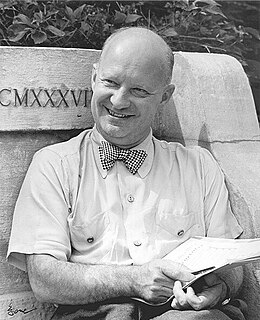| When Lilacs Last in the Dooryard Bloom'd: A Requiem for those we love | |
|---|---|
| Oratorio by Paul Hindemith | |
 The composer in 1945 | |
| Occasion | Memory of Franklin D. Roosevelt |
| Text | "When Lilacs Last in the Dooryard Bloom'd" by Walt Whitman |
| Language | English |
| Composed | 1946 |
| Performed | 14 May 1946: New York City |
| Movements | 11 |
| Scoring |
|
When Lilacs Last in the Dooryard Bloom'd: A Requiem for those we love (An American Requiem)[1] is a 1946 oratorio by composer Paul Hindemith, based on the poem of the same name by Walt Whitman. It is the first musical work to include the entirety of Whitman's 1865 poem.[2] Conductor Robert Shaw and the Robert Shaw Chorale commissioned the work after the 1945 death of President Franklin D. Roosevelt. It received its world premiere on May 14, 1946, at New York City Center, with the Collegiate Chorale conducted by Shaw and soloists Mona Paulee, contralto, and George Burnson, baritone.[3] Paulee performed the work again with bass-baritone Chester Watson and the CBS Symphony Orchestra for the work's first recorded broadcast on CBS Radio on June 30, 1946.[4]
David Neumeyer and others regard the Lilacs Requiem as Hindemith's "only profoundly American work."[5] Paul Hume said, "I doubt if we shall ever mourn Abraham Lincoln's untimely death more eloquently than in the words of Walt Whitman set to the music of Paul Hindemith; it is a work of genius and the presence of the genius presiding over its performance brought us splendor and profound and moving glory."[6]
The work is scored for mezzo-soprano and baritone soloists, SATB chorus, and full orchestra. After an unnumbered orchestral introduction, the text of the poem is divided into 11 movements:
- When lilacs last in the dooryard bloom'd (baritone and chorus)
- Arioso. In the swamp (mezzo-soprano)
- March. Over the breast of spring
- O western orb (baritone and chorus)
- Arioso. Sing on, there in the swamp
- Song. O how shall I warble
- Introduction and Fugue. Lo! body and soul
- Sing on! you gray-brown bird
- Death Carol. Come, lovely and soothing Death (chorus)
- To the tally of my soul
- Finale. Passing the visions (mezzo-soprano, baritone, and chorus)
The work is scored for mezzo-soprano and baritone soloists, mixed choir, and an orchestra of 2 flutes (one doubling piccolo), 2 oboes (one doubling cor anglais), clarinet, bass clarinet, 2 bassoons (one doubling contrabassoon), 3 horns, 2 trumpets, off-stage bugle, 2 trombones, tuba, timpani, cymbals, glockenspiel, chimes, tam-tam, triangle, snare drum, bass drum, field drum, organ, and strings (First & second violins, violas, cellos, and double basses).
- ^ Kowalke, Kim H. (1997). "For Those We Love: Hindemith, Whitman, and "An American Requiem"". Journal of the American Musicological Society. 50 (1): 133–174. doi:10.2307/832064. ISSN 0003-0139. JSTOR 832064.
- ^ "When Lilacs Last in the Dooryard Bloom'd", Wikipedia, 2022-06-04, retrieved 2022-09-08
- ^ Taubman, Howard (May 15, 1946). "Work By Hindemith In World Premiere". New York Times. Retrieved April 25, 2014.
- ^ "Today's Selections". The Washington Post. June 30, 1946. p. S6.
- ^ Sullivan, Jack (1999). New World Symphonies, p.122. ISBN 978-0-300-07231-0.
- ^ Kramer, Lawrence (2000). Walt Whitman and Modern Music, p.89. ISBN 978-0-8153-3154-4.